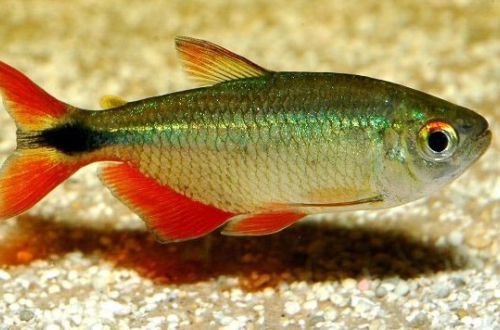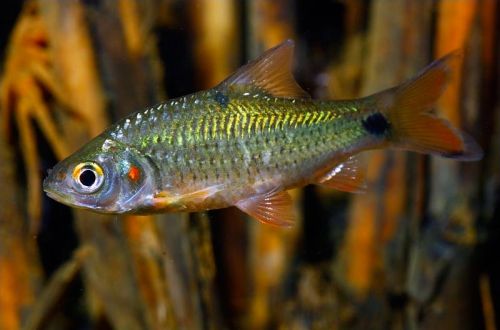
Diamond Tetra
The Diamond Tetra, scientific name Moenkhausia pittieri, belongs to the Characidae family. Perhaps the most luxurious and rich looking aquarium fish. In an adult individual, the scales acquire unique properties to reflect and decompose incident light into a spectrum, due to which it becomes like small diamonds.

Contents
Habitat
The fish was discovered in 1920 in Lake Valencia in Venezuela, later also found in a number of reservoirs in South America. Lake Valencia is the second largest in Venezuela, located between two mountain ranges. Currently, due to habitat pollution, the population of the Diamond Tetra has declined dramatically. In nature, they live in flocks, prefer small overgrown areas of the lake and tributaries. They feed on worms, crustaceans and insects.
Description
A rather stocky fish with a body flattened from the sides, no more than 6 cm in size. The main feature is the color, or rather the properties of the scales to reflect and refract light, as faceted crystals do. A similar effect is observed only in adult fish, young individuals are not very remarkable, they have a silvery color.
Food
It belongs to omnivorous species, with pleasure eats dry industrial and live food, as well as plant products. The diet should include vegetable supplements in addition to dry food, such as chopped lettuce or spinach leaves, vegetable flakes can be an alternative. This will prevent the aquarium plants from being eaten.
Maintenance and care
Water parameters have a small range of acceptable conditions. The fish requires soft, slightly acidic and very clean water. A productive filter with a filter material that acidifies the water is capable of solving the problem. Other necessary equipment is a heater, an aerator, and a lighting system that gives a weak light.
In the design, dense groups of plants are required. Floating plants are welcome, creating additional shade. The substrate is sandy with a few snags or roots, it is also advisable to place a few dry leaves (replace every two weeks) or pieces of wood to color the water in the faint brown color characteristic of the species’ natural habitat.
Social behavior
Friendly schooling and active fish, prefer the society of their species, are kept in groups of 5 individuals. Compatible with other peaceful fish of a similar or slightly smaller size, including viviparous species, tetras, as well as inhabitants of the bottom layers, for example, catfish.
Sexual differences
The differences mainly lie in the dorsal fin, in males it is longer and pointed, has the shape of a sickle.
Breeding / breeding
Breeding is quite simple, the main condition is that the male and female must be of the same age and size. Most of the failures are due to the neglect of this rule.
For breeding, a separate tank with a volume of 40 liters or more is required, the water parameters must match in most parameters, the only exception is water hardness, it must be at the level of 4 dGH. Standard equipment: filter, aerator, heater, lighting system. The design uses dense thickets of plants and sandy soil.
Before the start of spawning, the fish should be fed intensively, it is advisable to feed plant and meat products daily (freeze-dried is enough). Then the couple is transplanted into a separate tank and covered with a dark cloth, do not turn on the lighting. The next day, the fabric is removed, the lighting is still turned off, after a day the light should be turned on at the lowest power, etc. Gradually increasing the level of illumination can cause the breeding instinct in Diamond Tetras. When the eggs are laid, the parents are returned to the general aquarium.
Diseases
Fish are hardy and when kept in favorable conditions, health problems do not arise. For more information on symptoms and treatments, see the Aquarium Fish Diseases section.





